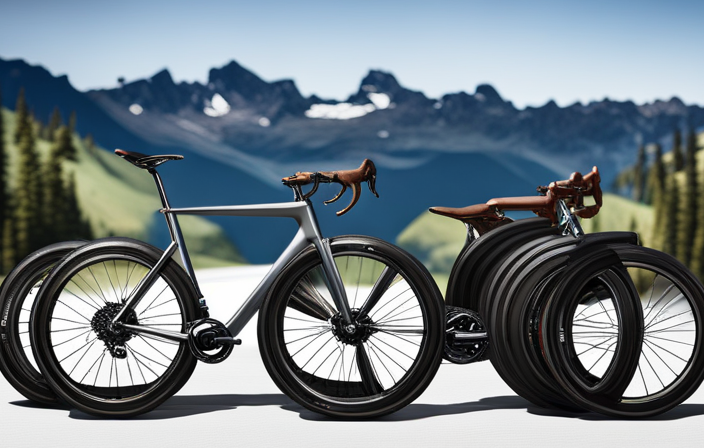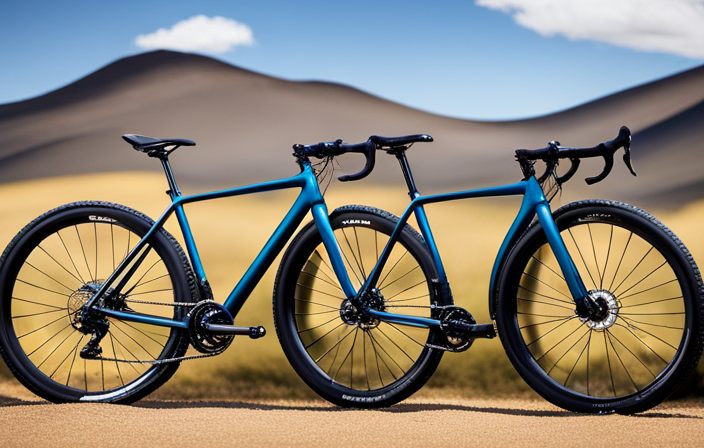Picture yourself driving along a dusty trail, experiencing the excitement of adventure beneath your wheels. A gravel road bike is your pass to discovering the wild beauty of nature and testing your boundaries on rough terrains.
In this article, I’ll take you on a journey into the world of gravel road biking, uncovering its history, key features, and the benefits it offers.
Get ready to dive into the technical aspects and gain in-depth knowledge that will fuel your passion for this thrilling two-wheeled pursuit.
Key Takeaways
- Gravel road bikes are specifically designed for off-road cycling on unpaved roads, gravel paths, and rough trails.
- Important features of gravel road bikes include wider tires for better traction, disc brakes for control, durable frame and fork for stability, and versatile gear ratios for tackling various terrains.
- Gravel road biking engages multiple muscle groups, improves cardiovascular fitness, boosts confidence, and allows exploration of hidden trails and scenic routes.
- When choosing and maintaining a gravel road bike, factors to consider include riding style, terrain preferences, weather conditions, frame material and geometry, components and accessories, as well as regular cleaning and maintenance tasks such as lubrication, tire pressure, and component inspection and adjustment.
A Brief History of Gravel Road Bikes
The gravel road bike, also known as a gravel grinder, has gained popularity in recent years. This is due to the growing interest in off-road cycling and the desire for a versatile bike that can handle various terrains. Gravel road bikes are specifically designed to tackle unpaved roads, gravel paths, and even rough trails.
Innovations in gravel road bikes have made them more capable than ever before. These bikes typically have wider tires with tread patterns that provide better traction on loose surfaces. They also feature disc brakes for enhanced stopping power and control, especially when riding in wet or muddy conditions. Additionally, many modern gravel road bikes offer multiple mounting points for racks and bags, allowing riders to carry their gear for longer adventures.
Famous gravel road bike routes have also contributed to the rise of this cycling discipline. The Dirty Kanza 200 in Kansas, Trans Iowa race in Iowa, and Oregon Outback route are just a few examples of challenging events that attract cyclists from around the world.
Moving forward into the key features of a gravel road bike…
The Key Features of a Gravel Road Bike
When discussing the key features of a gravel road bike, it is essential to consider the durable frame and fork. These components are designed to withstand rough terrains and provide stability during off-road adventures.
Additionally, wide tires are crucial for maintaining traction and stability on loose surfaces, while disc brakes offer reliable stopping power in all weather conditions.
Lastly, versatile gear ratios allow riders to tackle various terrains with ease, ensuring a smooth and efficient ride.
Durable Frame and Fork
Choose a gravel road bike with a durable frame and fork to ensure longevity and performance. The frame durability is crucial in handling the rough terrain and providing stability during off-road rides. Look for frames made from materials like aluminum or carbon fiber, as they offer excellent strength-to-weight ratios.
A sturdy fork is equally important, as it absorbs shocks and impacts while maintaining control over the bike. Consider opting for a carbon or steel fork, known for their resilience and ability to dampen vibrations effectively.
When visualizing your ideal gravel road bike, imagine a rugged frame built to withstand the harshest conditions, supported by a robust fork that effortlessly glides over obstacles. This combination ensures unmatched durability and provides confidence on any trail you may encounter.
Speaking of confidence, let’s explore another essential feature: wide tires for stability and traction…
Wide Tires for Stability and Traction
Opt for wide tires on your gravel road bike for enhanced stability and traction. When riding on uneven surfaces, such as gravel or dirt roads, having wider tires can greatly improve your overall riding experience.
Tire pressure optimization is crucial in ensuring maximum performance and comfort. By adjusting the tire pressure according to the terrain, you can achieve a smooth ride with reduced vibrations and increased grip.
Choosing the right tire width is also important. Generally, wider tires ranging from 35mm to 45mm provide better stability and traction on loose surfaces. However, it’s essential to consider factors like frame clearance and personal preferences when selecting the ideal tire width for your gravel road bike.
Now let’s move on to discussing disc brakes for reliable stopping power without compromising control and safety.
Disc Brakes for Reliable Stopping Power
For reliable stopping power on uneven surfaces, you’ll want to consider disc brakes. Disc brakes offer several advantages over traditional rim brakes, making them a popular choice for gravel road bikes. Here are four reasons why disc brakes are a great option:
-
Improved braking performance: Disc brakes provide consistent stopping power in all weather conditions, including wet and muddy terrain. This is because the braking force is applied directly to the rotor, rather than relying on friction between the rim and brake pads.
-
Better heat dissipation: The design of disc brakes allows for better heat dissipation, preventing overheating during prolonged descents and ensuring consistent performance.
-
Low maintenance: Compared to rim brakes, disc brakes require less frequent adjustment and replacement of brake pads. They also tend to be more resistant to wear and tear.
-
Compatibility with wider tires: Disc brakes allow for greater tire clearance, making it easier to fit wider tires on your gravel road bike for increased stability and traction.
With reliable stopping power taken care of, let’s move on to discussing versatile gear ratios for various terrains without missing a beat.
Versatile Gear Ratios for Various Terrains
When riding on different terrains, you’ll want to make sure your gear ratios are versatile enough to handle the varying conditions. Gear ratio selection is crucial in determining how efficiently you can pedal and maintain a comfortable cadence while tackling different terrains on a gravel road bike.
A versatile bike with a wide range of gear options allows you to easily switch between high and low gears, adapting to steep climbs or fast descents effortlessly. The benefits of a versatile gear ratio include improved power transfer, enhanced control, and increased speed capabilities. With the ability to fine-tune your gearing based on the terrain, you can optimize your pedaling efficiency and conquer any challenge that comes your way.
Speaking of benefits, let’s explore why riding a gravel road bike brings so many advantages over traditional road or mountain bikes.
The Benefits of Riding a Gravel Road Bike
If you’re looking for a versatile bike that allows you to explore various terrains, a gravel road bike is an excellent choice. Not only does it provide an exciting and adventurous riding experience, but it also offers numerous benefits for both your physical and mental well-being.
Physical Benefits: Riding a gravel road bike engages multiple muscle groups in your body, providing a full-body workout. The constant pedaling strengthens your legs, while the need to stabilize yourself on uneven surfaces works your core muscles. Additionally, the resistance from off-road cycling helps improve cardiovascular fitness and increases endurance.
Mental Benefits: Riding a gravel road bike can have a positive impact on your mental health. As you navigate through different terrains and tackle obstacles along the way, it boosts confidence and self-esteem. The immersive nature of gravel biking also allows you to disconnect from daily stressors and connect with nature, promoting relaxation and reducing anxiety.
Sense of Exploration: Gravel road biking opens up new possibilities for exploration as it takes you off the beaten path. You can discover hidden trails, scenic routes, and secluded areas that are inaccessible by traditional road bikes or cars.
Adventure and Freedom: Riding a gravel road bike gives you the freedom to go wherever the path leads you. It adds an element of adventure to your rides as you encounter challenging terrain and push yourself beyond your comfort zone.
Transitioning into how to choose the right gravel road bike for you…
How to Choose the Right Gravel Road Bike for You
When it comes to choosing the right gravel road bike for me, there are a few key points that I always consider.
First and foremost, I think about my riding style and the terrain that I’ll be tackling. Whether I prefer long endurance rides or more aggressive off-road adventures will greatly influence the type of bike that suits me best.
Secondly, frame material and geometry play a crucial role in finding the perfect fit and ride quality. The material used can affect the weight and durability of the bike, while the geometry determines its handling characteristics.
Lastly, components and accessories are important factors to consider as they can enhance performance and comfort on long rides. From drivetrain options to tire choices and handlebar configurations, every detail should align with my specific needs and preferences for an optimal gravel riding experience.
Consider Your Riding Style and Terrain
Considering your riding style and terrain, it’s important to choose a gravel road bike that suits your needs. When it comes to riding techniques, different riders have different preferences. Some riders enjoy the thrill of high-speed descents, while others prefer a more steady and controlled approach. Your gravel road bike should be able to handle these variations in riding style.
In terms of suitable clothing, it’s essential to consider the weather conditions you’ll be facing on your rides. If you often ride in wet or muddy conditions, investing in waterproof or water-resistant clothing can make a significant difference in your comfort level.
To help you understand how various bikes perform on different terrains, I’ve created a table for reference:
| Terrain | Recommended Bike Type | Features |
|---|---|---|
| Gravel | Gravel Road Bike | Wide tires for improved traction and stability |
| Pavement | Cyclocross Bike | Lighter frame for faster speeds on paved surfaces |
| Singletrack Trails | Mountain Bike | Suspension system for absorbing shocks |
Now that we’ve discussed the importance of considering riding style and terrain, let’s move on to exploring the impact of frame material and geometry on your gravel road bike performance.
Frame Material and Geometry
The frame material and geometry greatly affect the performance of your gravel bike. When it comes to frame materials, there are several options available, including aluminum, steel, carbon fiber, and titanium. Each material has its own strengths and characteristics that can impact the ride quality and durability of your bike.
Aluminum is lightweight and affordable, while steel offers a smooth ride and durability. Carbon fiber is extremely lightweight and stiff, providing excellent power transfer but at a higher cost. Titanium combines the best of both worlds with its lightweight yet durable nature.
In terms of geometry, gravel bikes typically have a longer wheelbase for stability on rough terrain and wider tire clearance for better traction. The head tube angle and fork rake also play a role in determining how the bike handles different surfaces.
Moving onto components and accessories…
Components and Accessories
One important aspect to consider when choosing components and accessories for your gravel bike is their compatibility with the frame material and geometry. It is crucial that the components and accessories you select are designed to work seamlessly with your bike’s specific frame design, ensuring optimal performance and durability. This is especially true for gravel bikes, as they often encounter rough terrain and demanding conditions.
To help you make informed decisions, I have created a table below highlighting some essential bike accessories and their importance in enhancing your gravel riding experience:
| Accessory | Importance |
|---|---|
| Tubeless Tires | Increased puncture resistance and lower rolling resistance |
| Hydraulic Disc Brakes | Improved stopping power in all weather conditions |
| Wide Gear Range | Allows for easier climbing on steep off-road sections |
| Suspension Seatpost | Absorbs shocks and vibrations for a smoother ride |
| Gravel-Specific Handlebars | Offers multiple hand positions for enhanced comfort |
Considering the significance of these components in optimizing your gravel riding experience, it is essential to choose wisely based on your riding style, preferences, and the terrain you plan to tackle.
When it comes to maintaining and caring for your gravel road bike, there are several tips that can help prolong its lifespan. [Transition sentence into the subsequent section about ‘tips for maintaining…’]
Tips for Maintaining and Caring for Your Gravel Road Bike
When it comes to maintaining my gravel road bike, there are three key points that I always focus on:
-
Regular cleaning and lubrication: This helps to remove dirt, grime, and debris from the bike’s moving parts, ensuring smooth operation.
-
Tire pressure and maintenance: Proper tire pressure and maintenance is crucial for optimal performance on different terrains.
-
Inspecting and adjusting components: This ensures that everything is in proper working order for a safe and efficient ride.
Taking the time to address these three areas of maintenance will help keep my gravel road bike in top condition for all my rides.
Regular Cleaning and Lubrication
To keep your gravel road bike running smoothly, make sure you regularly clean and lubricate it. Cleaning techniques for a gravel road bike include using a mild detergent and water to remove dirt and grime from the frame, wheels, and drivetrain. It’s important to pay extra attention to hard-to-reach areas such as the bottom bracket and chainrings. After cleaning, be sure to dry the bike thoroughly to prevent rust.
When it comes to lubrication, it’s recommended to use a high-quality chain lube specifically designed for off-road riding. Apply the lube sparingly on the chain while turning the pedals backwards to ensure even distribution. Additionally, don’t forget to lubricate other moving parts such as derailleurs and brake pivots.
Maintaining proper tire pressure is crucial for optimal performance on gravel roads. Now let’s move on to tire pressure and maintenance.
To maintain your gravel road bike in top condition, regular cleaning and lubrication are essential steps. Cleaning techniques involve using mild detergent mixed with water for removing dirt from various parts like wheels, frame, and drivetrain areas of your bicycle. Paying attention to often overlooked spots including bottom brackets is vital too! After cleaning thoroughly, remember drying your bike entirely must be done correctly; otherwise rust may set in! Next comes lubrication where opting for high-quality chain lube specifically designed for off-road usage is highly recommended! Applying this lube sparingly while pedaling backward ensures even spread across the entire chain assembly effectively reducing wear & tear! Keep in mind that other moving components like derailleurs or brake pivots also require regular lubrication! Lastly, maintaining appropriate tire pressure plays an integral role in ensuring peak performance on unpaved terrains.
To ensure optimal performance of your gravel road bike, it is imperative that you regularly clean and lubricate it. Utilize gentle cleaning techniques by employing a mild detergent mixed with water solution when removing dirt from various parts of your bike such as the frame, wheels, and drivetrain. Pay special attention to hard-to-reach areas like the bottom bracket and chainrings. After cleaning, make sure to thoroughly dry your bike to prevent rust formation.
When it comes to lubrication, it is recommended that you use high-quality lubricants specifically designed for off-road biking. Apply the lubricant sparingly onto the chain while pedaling backward to ensure even distribution. Don’t forget to also lubricate other moving components such as derailleurs and brake pivots. Proper tire pressure maintenance is vital for optimal performance on gravel roads. Now let’s delve into tire pressure and maintenance without further ado.
To maintain peak performance of your gravel road bike, regular cleaning and lubrication are crucial steps that should not be overlooked. Cleaning techniques involve using a mild detergent mixed with water solution to effectively remove dirt and grime from various parts of your bike including the frame, wheels, and drivetrain. It is important to pay close attention to hard-to-reach areas such as the bottom bracket and chainrings during this process.
Once cleaned, ensuring thorough drying is essential in order to prevent any potential rust or corrosion issues down the line. When it comes to lubrication, opting for recommended high-quality lubes designed specifically for off-road riding will help enhance overall performance and longevity of your bike’s components. Applying these lubes sparingly on key areas like the chain while turning the pedals backwards guarantees an even distribution throughout the drivetrain system.
Remembering proper maintenance practices like maintaining adequate tire pressure will contribute significantly towards a more enjoyable gravel riding experience ahead!
Tire Pressure and Maintenance
Make sure you regularly check and maintain the tire pressure of your gravel road bike. Proper tire pressure is crucial for optimal performance and to prevent common maintenance issues. The recommended tire pressure can vary depending on factors such as rider weight, terrain, and personal preference. To help you understand the importance of tire pressure, refer to the table below:
| Rider Weight | Tire Width (mm) | Recommended Pressure (psi) |
|---|---|---|
| 100-150 lbs | 32-38 | 40-50 |
| 150-200 lbs | 38-42 | 45-55 |
| >200 lbs | 42-45 | 50-60 |
Maintaining proper tire pressure can enhance traction, reduce rolling resistance, and minimize the risk of flats. Common maintenance issues related to tire pressure include pinch flats from underinflated tires and reduced performance due to overinflation. Now that we’ve covered tire pressure and maintenance, let’s move on to inspecting and adjusting components for a thorough check-up of your gravel road bike.
Inspecting and Adjusting Components
Inspecting and adjusting components is an essential part of maintaining your gravel road bike’s performance. To ensure optimal functionality, it’s crucial to regularly inspect various components and make necessary adjustments using appropriate tools. Here are some techniques for inspecting and adjusting components:
-
Wheel alignment: Check that the wheels are properly aligned with the frame, ensuring a smooth ride and preventing premature wear.
-
Brake adjustment: Inspect brake pads for wear and adjust them to provide optimal stopping power.
-
Gear indexing: Ensure smooth gear shifting by inspecting the derailleur alignment and making adjustments as needed.
-
Chain lubrication: Regularly inspect the chain for dirt or rust, clean it thoroughly, and apply lubricant to reduce friction.
By performing these inspections and adjustments, you can maintain your gravel road bike in top condition for a safe and enjoyable riding experience.
Now let’s move on to discussing essential accessories for gravel road biking.
Essential Accessories for Gravel Road Biking
When gravel road biking, it’s important to have the essential accessories. These accessories not only enhance your riding experience but also ensure that you are prepared for any situation that may arise during your journey.
One of the first things to consider is gravel road bike maintenance. Having a reliable set of tools including a multitool, tire levers, and a mini pump can make all the difference when it comes to fixing minor issues on the go.
In addition to maintenance tools, there are several gravel road bike accessories that can greatly improve your comfort and safety. A good quality helmet is essential for protecting your head in case of accidents, while padded gloves provide extra cushioning and reduce hand fatigue during long rides. It’s also worth investing in a pair of durable cycling shoes with grippy soles for better pedaling efficiency and stability on rough terrain.
To ensure you have everything you need, consider adding other accessories such as a hydration pack or water bottle cage for staying hydrated, lights for increased visibility during low light conditions, and a saddlebag or frame bag for carrying essentials like spare tubes and nutrition.
These essential accessories will help you get the most out of your gravel road biking experience by keeping you safe, comfortable, and well-prepared. Now let’s explore some popular gravel road bike races and events where you can put these accessories to use without skipping a beat.
Popular Gravel Road Bike Races and Events
One of the most popular gravel road bike races and events is the Dirty Kanza, where cyclists can test their skills and endurance on challenging off-road terrain. This 200-mile race takes place in the Flint Hills of Kansas and attracts riders from around the world. The course features a mix of gravel roads, rocky sections, and steep climbs, making it a true test of both physical fitness and bike handling skills.
Another well-known event is the Belgian Waffle Ride, held in San Diego, California. This unique race combines elements of road racing with off-road sections, creating a challenging and unpredictable course. With its demanding climbs and technical descents, it has become a favorite among gravel enthusiasts.
The Grinduro series is another popular choice for gravel road bike racers. These events combine gravel racing with elements of mountain biking and cyclocross to create a truly diverse racing experience. Held in various locations across North America, Europe, and Australia, these races offer riders the chance to explore stunning landscapes while pushing themselves to their limits.
Transitioning into the subsequent section about inspiring gravel road bike routes around the world:
As thrilling as these races may be, sometimes we just want to get out there and enjoy some epic rides on our own terms.
Inspiring Gravel Road Bike Routes Around the World
Let’s explore some incredible routes around the world that will inspire your off-road cycling adventures. Whether you’re a seasoned gravel road biker or just starting out, these inspiring destinations will leave you in awe of the beauty and challenge they offer.
-
The Transcontinental Race: This epic route takes riders across Europe, from Belgium to Greece, covering over 4,000 kilometers of varied terrain. It’s a true test of endurance and navigation skills.
-
The Dirty Kanza: Held annually in Kansas, USA, this race is known for its unforgiving Flint Hills gravel roads. With distances ranging from 100 to 350 miles, it attracts riders from all over the world.
-
The Silk Road Mountain Race: Taking place in Kyrgyzstan, this route follows ancient trade routes through remote mountains and valleys. It’s an adventure like no other, with breathtaking scenery and challenging climbs.
-
The Great Divide Mountain Bike Route: Stretching over 2,700 miles from Canada to Mexico, this iconic route offers a mix of gravel roads and rugged trails. It’s a bucket list ride for many off-road enthusiasts.
When embarking on these inspiring journeys, it’s crucial to ensure your gravel road bike is properly maintained. Regular cleaning and lubrication of the drivetrain are essential for smooth shifting and optimal performance. Additionally, checking tire pressure and inspecting brake pads can help prevent any unwanted surprises along the way.
Now let me share some stories and testimonials from gravel road biking enthusiasts who have experienced these incredible routes firsthand.
Stories and Testimonials from Gravel Road Biking Enthusiasts
Exploring the incredible routes around the world, gravel road biking enthusiasts share their inspiring stories and testimonials. As a passionate gravel road biker myself, I have come across numerous challenges and triumphs that have shaped my love for this exhilarating sport. From conquering rugged terrains to experiencing breathtaking landscapes, every ride has been an adventure worth cherishing.
To further enhance my gravel road biking experience, I have acquired in-depth knowledge about bike maintenance and techniques for improving performance. Regular maintenance is crucial to ensure optimal functionality of your gravel road bike. This includes cleaning and lubricating the drivetrain, checking tire pressure, and inspecting brakes for wear and tear. By following these steps diligently, you can prevent mechanical issues during your rides.
Additionally, there are several tips that can help boost your gravel road bike’s performance. Upgrading to tubeless tires not only reduces the risk of punctures but also enhances traction on loose surfaces. Adjusting tire pressure according to terrain conditions can greatly improve control and comfort. Experimenting with different handlebar widths can also provide better stability and handling.
Transitioning into the subsequent section about ‘how to prepare for your first gravel road bike ride,’ it is essential to consider these maintenance tips along with other preparation strategies to ensure a safe and enjoyable adventure on your new gravel road bike.
How to Prepare for Your First Gravel Road Bike Ride
To get ready for your first adventure on the rugged terrain, make sure you are well-prepared and equipped with the necessary gear. Here are three essential tips for beginners to ensure a safe and enjoyable gravel road biking experience:
-
Tire Selection: Opt for wider tires with knobby treads to provide better traction and stability on loose gravel surfaces. This will help prevent skidding and increase control over your bike.
-
Bike Maintenance: Before hitting the gravel road, thoroughly check your bike’s brakes, gears, and chain. Ensure they are in good working condition to avoid any unexpected mechanical issues during your ride.
-
Safety Precautions: Gravel roads can be unpredictable, so it’s crucial to wear a properly fitted helmet for protection. Additionally, invest in gloves and knee pads to safeguard against potential falls or scrapes.
By following these tips for beginners and taking necessary safety precautions, you’ll be well-prepared for your first gravel road bike ride.
In the next section about ‘gravel road bike vs. road bike vs. mountain bike: a comparison,’ we’ll explore the key differences between these types of bikes without skipping a beat in terms of performance capabilities.
NEXT SUBTOPIC: ‘Gravel Road Bike vs. Road Bike vs. Mountain Bike: A Comparison’
Gravel Road Bike vs. Road Bike vs. Mountain Bike: A Comparison
Make sure you understand the key differences between these three types of bikes so you can choose the one that best suits your needs. When comparing a gravel road bike to a road bike and a mountain bike, there are several important factors to consider.
Firstly, let’s discuss the gravel road bike versus the cyclocross bike. While both bikes are designed for off-road riding, there are some distinctions. Gravel road bikes typically have more relaxed geometry, wider tires, and additional features like rack mounts for carrying gear. Cyclocross bikes, on the other hand, are built for racing on off-road courses with obstacles and require more agility and responsiveness.
When it comes to fitness and wellness benefits, gravel road biking offers unique advantages. The varied terrain of gravel roads provides an excellent workout for both cardiovascular endurance and strength training. The constant need to adapt to changing surfaces engages different muscle groups in your body. Additionally, riding on gravel can be less jarring on your joints compared to mountain biking on rough trails.
In conclusion, understanding the differences between a gravel road bike, a road bike, and a mountain bike is crucial in making an informed decision about which one is right for you. Now let’s delve into the future of gravel road biking and industry trends without losing momentum in this exciting sport.
The Future of Gravel Road Biking and Industry Trends
Get ready to embrace the future of off-road biking and discover the exciting industry trends that await you in this exhilarating sport. The world of gravel road biking is constantly evolving, with new innovations and advancements shaping the way we ride. Here are some key industry trends to keep an eye on:
-
Integration of technology: With the rise of smart devices, gravel road bikes are becoming more connected than ever before. From GPS navigation systems to integrated power meters, these technological advancements enhance the overall riding experience.
-
Gravel-specific components: Manufacturers are designing components specifically for gravel road bikes, such as wider tires for better traction on loose surfaces and disc brakes for improved stopping power. These specialized features allow riders to tackle any terrain with confidence.
-
Rise of gravel road bike races: As the popularity of gravel road biking continues to grow, so does the number of organized races. These events attract both professional athletes and recreational riders alike, providing a platform to showcase skills and push boundaries.
-
Sustainable materials: The industry is increasingly focused on developing environmentally friendly materials for bike manufacturing. From recycled carbon fiber frames to bio-based lubricants, sustainability is becoming a top priority.
-
Customization options: Riders now have more options when it comes to customizing their bikes. From paint colors to component choices, manufacturers are offering personalized options that allow cyclists to create a bike that perfectly suits their needs and style.
As you delve into the world of gravel road biking and explore these exciting industry trends, you’ll quickly realize why joining the gravel road biking community through clubs and online resources is essential for your journey towards mastering this thrilling sport.
Joining the Gravel Road Biking Community: Clubs and Online Resources
Embrace the camaraderie and support of fellow enthusiasts by joining gravel road biking clubs and accessing online resources. Being part of the gravel road bike community not only provides a sense of belonging, but also offers valuable opportunities to learn from experienced riders and discover new routes.
Online platforms dedicated to gravel road biking, such as forums, social media groups, and websites, are excellent sources for connecting with like-minded individuals. These resources enable riders to share tips, experiences, and information about upcoming events or organized rides. Additionally, many cycling clubs have specific sections or subgroups focused on gravel road biking. Joining these clubs allows riders to participate in group rides, receive guidance from seasoned cyclists, and gain access to exclusive events.
When it comes to finding new routes for your gravel road bike adventures, online resources can be invaluable. Websites like Ride with GPS or GravelMap provide detailed maps and descriptions of popular routes contributed by other members of the community. These platforms often include information about terrain difficulty levels, surface conditions, and points of interest along the way.
Transitioning into the subsequent section about sustainable practices in gravel road biking involves considering our impact on the environment while enjoying this sport responsibly.
Sustainable Practices in Gravel Road Biking
When it comes to gravel road biking, there’s more to it than just the thrill of riding off-road. As an avid cyclist myself, I understand the importance of sustainable practices and minimizing our environmental impact.
Gravel road biking can have a significant effect on the surrounding ecosystems if not done responsibly.
One of the key sustainable practices in gravel road biking is trail maintenance. By properly maintaining the trails we ride on, we can ensure their longevity and minimize erosion caused by heavy bike traffic. This includes repairing damage, removing debris, and avoiding sensitive areas such as wetlands or endangered habitats.
Another aspect to consider is responsible waste management. It’s essential to carry out any trash we generate during our rides and dispose of it properly at designated facilities. Additionally, using reusable water bottles and other eco-friendly gear can significantly reduce our waste footprint.
By incorporating these sustainable practices into our gravel road biking adventures, we can enjoy the beauty of nature while minimizing our impact on the environment. It’s crucial for us as a community to prioritize sustainability so that future generations can also experience the joy of riding through untouched landscapes.
As I conclude this discussion on sustainable practices in gravel road biking, let’s transition into embracing the adventure that awaits us in this exhilarating sport.
Final Thoughts: Embrace the Adventure of Gravel Road Biking
Incorporating sustainable practices into our gravel rides allows us to fully immerse ourselves in the adventure that awaits. As gravel road bikers, we are constantly seeking new challenges and pushing our limits. Embracing these challenges not only builds resilience but also adds an element of excitement to our rides.
Here are four ways in which we can embrace the adventure of gravel road biking:
-
Conquer steep climbs: Gravel roads often present us with steep inclines that test our strength and endurance. By tackling these challenging climbs head-on, we build both physical and mental resilience.
-
Navigate technical descents: Gravel roads can be unpredictable, with loose surfaces and sharp turns. Riding through these technical descents requires skill and focus, adding an extra layer of thrill to our adventures.
-
Explore remote landscapes: Gravel road biking takes us off the beaten path, allowing us to explore remote and untouched landscapes. The feeling of venturing into uncharted territory is truly exhilarating.
-
Adapt to changing conditions: Gravel riding means dealing with various weather conditions and terrains. From muddy trails to rocky paths, adapting on-the-go tests our adaptability and problem-solving skills.
By embracing these challenges and building resilience along the way, we not only become better riders but also gain a deeper appreciation for the beauty of gravel road biking.
So let’s strap on our helmets, hop on our bikes, and embrace the adventurous spirit that awaits us on those dusty gravel roads!
Frequently Asked Questions
Are gravel road bikes suitable for beginners or only experienced riders?
Gravel road bikes are suitable for both beginners and experienced riders. They offer several benefits that make them beginner-friendly.
These bikes have wider tires, providing stability and control on loose surfaces. The relaxed geometry ensures a comfortable riding position, reducing strain on the body during long rides. Additionally, gravel road bikes often feature disc brakes for reliable stopping power in various conditions.
Overall, these features make gravel road bikes an excellent choice for beginners looking to explore off-road adventures.
What kind of terrain can gravel road bikes handle?
Gravel road bikes excel at handling a wide range of terrains, making them versatile options for riders. With their sturdy construction and wider tires, they can tackle gravel roads, dirt paths, and even moderate trails with ease.
The advantages of gravel road bikes lie in their stability, comfort, and durability. Some of the best gravel road bike brands known for producing high-quality models include Specialized, Giant, Trek, Cannondale, and Salsa. These brands offer a variety of options to suit different riding preferences and budgets.
Can I use a gravel road bike for commuting or is it only for off-road riding?
A gravel road bike can definitely be used for commuting, in addition to off-road riding. The benefits of using a gravel road bike for commuting are numerous.
Firstly, the wider tires provide better stability and control on different types of terrain, including pavement and gravel roads.
Secondly, the relaxed geometry of a gravel road bike offers a more comfortable riding position for longer commutes.
Additionally, the versatility of a gravel road bike allows you to easily add racks or panniers for carrying your belongings.
In comparison to traditional road bikes, gravel road bikes have greater clearance for wider tires and often come with mounts for fenders and racks, making them ideal for commuting even in unfavorable weather conditions.
How does the weight of a gravel road bike affect performance?
The weight of a gravel road bike plays a crucial role in its performance. A lighter bike offers several advantages, such as better acceleration and maneuverability, making it easier to navigate through rough terrains.
Additionally, the tire width impacts the bike’s performance as wider tires provide more stability and traction on loose surfaces.
However, it is important to strike a balance between weight and durability to ensure the bike can withstand off-road conditions without compromising speed and efficiency.
Are there any specific clothing or gear recommendations for gravel road biking?
When venturing onto the untamed paths of gravel roads, one must choose their armor wisely. The importance of tire selection cannot be overstated. Opt for wider tires with lower pressure to handle the unpredictable terrain.
As for clothing, it is crucial to adapt to ever-changing weather conditions. Layering is key, as it allows you to shed or add garments as needed. Don’t forget essentials like a waterproof jacket and gloves for those muddy adventures.
Conclusion
In conclusion, embracing the adventure of gravel road biking is a thrilling and rewarding experience. The versatility and durability of gravel road bikes make them perfect for exploring off-road trails and tackling challenging terrains. With their key features like wider tires, disc brakes, and endurance-focused geometry, these bikes offer stability and control.
By choosing the right gravel road bike for your needs and properly maintaining it, you can ensure a smooth ride every time. So why wait? Dive into the world of gravel road biking and uncover new horizons with each pedal stroke.
Rhetorical Device: Hyperbole – ‘uncover new horizons with each pedal stroke’ emphasizes the limitless possibilities and sense of exploration that comes with gravel road biking.









